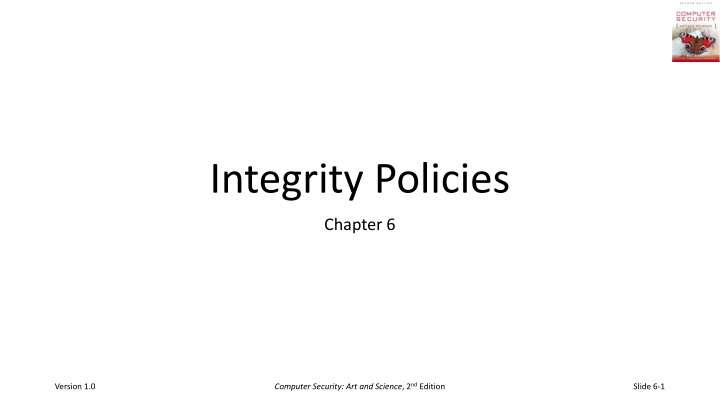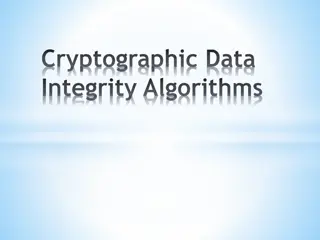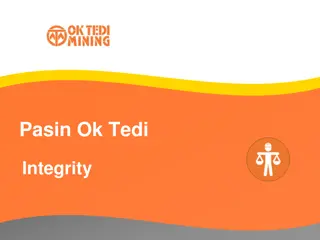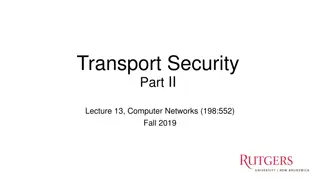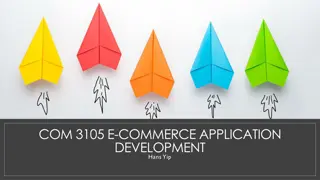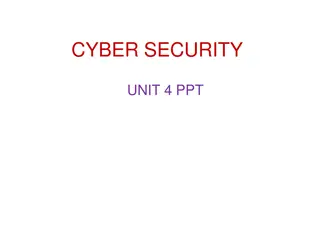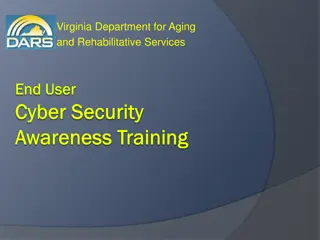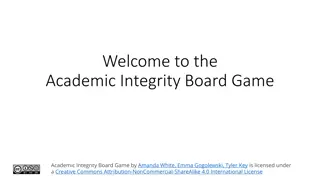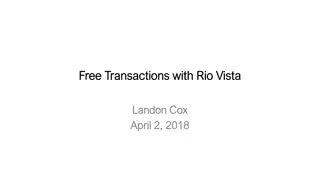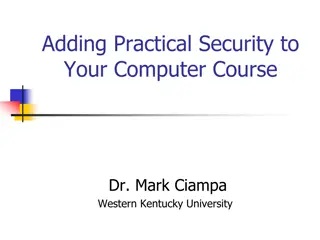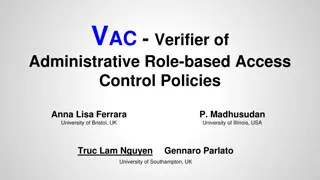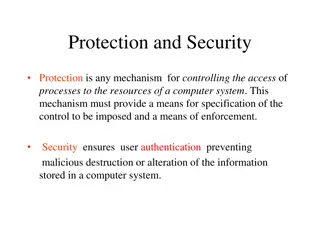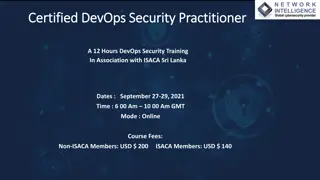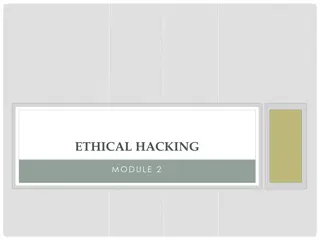Computer Security: Integrity Policies Overview
In the realm of computer security, integrity policies play a crucial role in safeguarding data and ensuring system reliability. This content delves into the requirements, principles, and models related to integrity policies, emphasizing the importance of maintaining data accuracy and reliability. By exploring topics such as the Biba integrity model and integrity levels, users can grasp the nuances of implementing effective integrity policies to enhance overall system security.
Download Presentation

Please find below an Image/Link to download the presentation.
The content on the website is provided AS IS for your information and personal use only. It may not be sold, licensed, or shared on other websites without obtaining consent from the author.If you encounter any issues during the download, it is possible that the publisher has removed the file from their server.
You are allowed to download the files provided on this website for personal or commercial use, subject to the condition that they are used lawfully. All files are the property of their respective owners.
The content on the website is provided AS IS for your information and personal use only. It may not be sold, licensed, or shared on other websites without obtaining consent from the author.
E N D
Presentation Transcript
Integrity Policies Chapter 6 Computer Security: Art and Science, 2nd Edition Version 1.0 Slide 6-1
Overview Requirements Very different than confidentiality policies Biba s models Strict Integrity policy Lipner s model Combines Bell-LaPadula, Biba Clark-Wilson model Trust models Policy-based Reputation-based Computer Security: Art and Science, 2nd Edition Version 1.0 Slide 6-2
Requirements of Policies 1.Users will not write their own programs, but will use existing production programs and databases. 2.Programmers will develop and test programs on a non-production system; if they need access to actual data, they will be given production data via a special process, but will use it on their development system. 3.A special process must be followed to install a program from the development system onto the production system. 4.The special process in requirement 3 must be controlled and audited. 5.The managers and auditors must have access to both the system state and the system logs that are generated. Computer Security: Art and Science, 2nd Edition Version 1.0 Slide 6-3
Principles of Operation Separation of duty: if two or more steps are required to perform a critical function, at least two different people should perform the steps Separation of function: different entities should perform different functions Auditing: recording enough information to ensure the abilities to both recover and determine accountability Computer Security: Art and Science, 2nd Edition Version 1.0 Slide 6-4
Biba Integrity Model Basis for all 3 models: Set of subjects S, objects O, integrity levels I, relation I I holding when second dominates first min: I I I returns lesser of integrity levels i: S O I gives integrity level of entity r: S O means s S can read o O w, x defined similarly Computer Security: Art and Science, 2nd Edition Version 1.0 Slide 6-5
Intuition for Integrity Levels The higher the level, the more confidence That a program will execute correctly That data is accurate and/or reliable Note relationship between integrity and trustworthiness Important point: integrity levels are not security levels Computer Security: Art and Science, 2nd Edition Version 1.0 Slide 6-6
Information Transfer Path An information transfer path is a sequence of objects o1, ..., on+1 and corresponding sequence of subjects s1, ..., sn such that si r oi and si w oi+1 for all i, 1 i n. Idea: information can flow from o1 to on+1 along this path by successive reads and writes Computer Security: Art and Science, 2nd Edition Version 1.0 Slide 6-7
Low-Water-Mark Policy Idea: when s reads o, i(s) = min(i(s), i (o)); s can only write objects at lower levels Rules 1. s S can write to o O if and only if i(o) i(s). 2.If s S reads o O, then i (s) = min(i(s), i(o)), where i (s) is the subject s integrity level after the read. 3. s1 S can execute s2 S if and only if i(s2) i(s1). Computer Security: Art and Science, 2nd Edition Version 1.0 Slide 6-8
Information Flow and Model If information transfer path from o1 O to on+1 O, enforcement of low-water-mark policy requires i(on+1) i(o1) for all n > 1. Idea of proof: Assume information transfer path exists between o1 and on+1. Assume that each read and write was performed in the order of the indices of the vertices. By induction, the integrity level for each subject is the minimum of the integrity levels for all objects preceding it in path, so i(sn) i(o1). As nth write succeeds, i(on+1) i(sn). Hence i(on+1) i(o1). Computer Security: Art and Science, 2nd Edition Version 1.0 Slide 6-9
Problems Subjects integrity levels do not increase as system runs Soon no subject will be able to access objects at high integrity levels Alternative: change object levels rather than subject levels Soon all objects will be at the lowest integrity level Crux of problem is model prevents indirect modification Because subject levels lowered when subject reads from low-integrity object Computer Security: Art and Science, 2nd Edition Version 1.0 Slide 6-10
Ring Policy Idea: subject integrity levels static Rules 1. s S can write to o O if and only if i(o) i(s). 2. Any subject can read any object. 3. s1 S can execute s2 S if and only if i(s2) i(s1). Difference with low-water-mark policy is any subject can read any object Eliminates indirect modification problem Same information flow result holds Computer Security: Art and Science, 2nd Edition Version 1.0 Slide 6-11
Strict Integrity Policy Dual of Bell-LaPadula model 1. s S can read o O iff i(s) i(o) 2. s S can write to o O iff i(o) i(s) 3. s1 S can execute s2 S iff i(s2) i(s1) Add compartments and discretionary controls to get full dual of Bell- LaPadula model Information flow result holds Different proof, though Term Biba Model refers to this Computer Security: Art and Science, 2nd Edition Version 1.0 Slide 6-12
LOCUS and Biba Goal: prevent untrusted software from altering data or other software Approach: make levels of trust explicit credibility ratingbased on estimate of software s trustworthiness (0 untrusted, n highly trusted) trusted file systems contain software with a single credibility level Process has risk level or highest credibility level at which process can execute Must use run-untrusted command to run software at lower credibility level Computer Security: Art and Science, 2nd Edition Version 1.0 Slide 6-13
Integrity Matrix Model Lipner proposed this as first realistic commercial model Combines Bell-LaPadula, Biba models to obtain model conforming to requirements Do it in two steps Bell-LaPadula component first Add in Biba component Computer Security: Art and Science, 2nd Edition Version 1.0 Slide 6-14
Bell-LaPadula Clearances 2 security clearances/classifications AM (Audit Manager): system audit, management functions SL (System Low): any process can read at this level Computer Security: Art and Science, 2nd Edition Version 1.0 Slide 6-15
Bell-LaPadula Categories 5 categories D (Development): production programs in development but not yet in use PC (Production Code): production processes, programs PD (Production Data): data covered by integrity policy SD (System Development): system programs in development but not yet in use T (Software Tools): programs on production system not related to protected data Computer Security: Art and Science, 2nd Edition Version 1.0 Slide 6-16
Users and Security Levels Subjects Security Level Ordinary users Application developers (SL, { PC, PD }) (SL, { D, T }) System programmers System managers and auditors (SL, { SD, T }) (AM, { D, OC, OD, SD, T }) System controllers (SL, {D, PC, PD, SD, T}) and downgrade privilege Version 1.0 Computer Security: Art and Science, 2nd Edition Slide 6-17
Objects and Classifications Objects Security Level Development code/test data Production code Production data Software tools System programs System programs in modification System and application logs (SL, { D, T }) (SL, { PC }) (SL, { PC, PD }) (SL, { T }) (SL, ) (SL, { SD, T }) (AM, { appropriate }) Version 1.0 Computer Security: Art and Science, 2nd Edition Slide 6-18
Ideas Ordinary users can execute (read) production code but cannot alter it Ordinary users can alter and read production data System managers need access to all logs but cannot change levels of objects System controllers need to install code (hence downgrade capability) Logs are append only, so must dominate subjects writing them Computer Security: Art and Science, 2nd Edition Version 1.0 Slide 6-19
Check Requirements 1. 2. Users have no access to T, so cannot write their own programs Applications programmers have no access to PD, so cannot access production data; if needed, it must be put into D, requiring the system controller to intervene Installing a program requires downgrade procedure (from D to PC), so only system controllers can do it 3. Computer Security: Art and Science, 2nd Edition Version 1.0 Slide 6-20
More Requirements 4. Control: only system controllers can downgrade; audit: any such downgrading must be altered 5. System management and audit users are in AM and so have access to system styate and logs Computer Security: Art and Science, 2nd Edition Version 1.0 Slide 6-21
Problem Too inflexible System managers cannot run programs for repairing inconsistent or erroneous production database System managers at AM, production data at SL So add more Computer Security: Art and Science, 2nd Edition Version 1.0 Slide 6-22
Adding Biba 3 integrity classifications ISP(System Program): for system programs IO (Operational): production programs, development software ISL (System Low): users get this on log in 2 integrity categories ID (Development): development entities IP (Production): production entities Computer Security: Art and Science, 2nd Edition Version 1.0 Slide 6-23
Simplify Bell-LaPadula Reduce security categories to 3: SP (Production): production code, data SD (Development): same as D SSD (System Development): same as old SD Computer Security: Art and Science, 2nd Edition Version 1.0 Slide 6-24
Users and Levels Subjects Security Level Integrity Level Ordinary users (SL, { SP }) (ISL, { IP }) Application developers (SL, { SD }) (ISL, { ID }) System programmers (SL, { SSD }) (ISL, { ID }) System managers and auditors (AM, { SP, SD, SSD }) (ISL, { IP, ID}) System controllers (SL, { SP, SD }) and downgrade privilege (ISP, { IP, ID}) Repair (SL, { SP }) (ISL, { IP }) Version 1.0 Computer Security: Art and Science, 2nd Edition Slide 6-25
Objects and Classifications Objects Security Level Integrity Level Development code/test data (SL, { SD }) (ISL, { IP} ) Production code (SL, { SP }) (IO, { IP }) Production data (SL, { SP }) (SL, ) (SL, ) (SL, { SSD }) (ISL, { IP }) Software tools (IO, { ID }) System programs (ISP, { IP, ID }) System programs in modification (ISL, { ID }) (ISL, ) System and application logs (AM, { appropriate }) Repair (SL, {SP}) (ISL, { IP }) Version 1.0 Computer Security: Art and Science, 2nd Edition Slide 6-26
Ideas Security clearances of subjects same as without integrity levels Ordinary users need to modify production data, so ordinary users must have write access to integrity category IP Ordinary users must be able to write production data but not production code; integrity classes allow this Note writing constraints removed from security classes Computer Security: Art and Science, 2nd Edition Version 1.0 Slide 6-27
Clark-Wilson Integrity Model Integrity defined by a set of constraints Data in a consistent or valid state when it satisfies these Example: Bank Dtoday s deposits, W withdrawals, YByesterday s balance, TBtoday s balance Integrity constraint: D + YB W Well-formed transaction move system from one consistent state to another Issue: who examines, certifies transactions done correctly? Computer Security: Art and Science, 2nd Edition Version 1.0 Slide 6-28
Entities CDIs: constrained data items Data subject to integrity controls UDIs: unconstrained data items Data not subject to integrity controls IVPs: integrity verification procedures Procedures that test the CDIs conform to the integrity constraints TPs: transaction procedures Procedures that take the system from one valid state to another Computer Security: Art and Science, 2nd Edition Version 1.0 Slide 6-29
Certification Rules 1 and 2 CR1 When any IVP is run, it must ensure all CDIs are in a valid state CR2 For some associated set of CDIs, a TP must transform those CDIs in a valid state into a (possibly different) valid state Defines relation certified that associates a set of CDIs with a particular TP Example: TP balance, CDIs accounts, in bank example Computer Security: Art and Science, 2nd Edition Version 1.0 Slide 6-30
Enforcement Rules 1 and 2 ER1 The system must maintain the certified relations and must ensure that only TPs certified to run on a CDI manipulate that CDI. ER2 The system must associate a user with each TP and set of CDIs. The TP may access those CDIs on behalf of the associated user. The TP cannot access that CDI on behalf of a user not associated with that TP and CDI. System must maintain, enforce certified relation System must also restrict access based on user ID (allowed relation) Computer Security: Art and Science, 2nd Edition Version 1.0 Slide 6-31
Users and Rules CR3 The allowed relations must meet the requirements imposed by the principle of separation of duty. ER3 The system must authenticate each user attempting to execute a TP Type of authentication undefined, and depends on the instantiation Authentication not required before use of the system, but is required before manipulation of CDIs (requires using TPs) Computer Security: Art and Science, 2nd Edition Version 1.0 Slide 6-32
Logging CR4 All TPs must append enough information to reconstruct the operation to an append-only CDI. This CDI is the log Auditor needs to be able to determine what happened during reviews of transactions Computer Security: Art and Science, 2nd Edition Version 1.0 Slide 6-33
Handling Untrusted Input CR5 Any TP that takes as input a UDI may perform only valid transformations, or no transformations, for all possible values of the UDI. The transformation either rejects the UDI or transforms it into a CDI. In bank, numbers entered at keyboard are UDIs, so cannot be input to TPs. TPs must validate numbers (to make them a CDI) before using them; if validation fails, TP rejects UDI Computer Security: Art and Science, 2nd Edition Version 1.0 Slide 6-34
Separation of Duty In Model ER4 Only the certifier of a TP may change the list of entities associated with that TP. No certifier of a TP, or of an entity associated with that TP, may ever have execute permission with respect to that entity. Enforces separation of duty with respect to certified and allowed relations Computer Security: Art and Science, 2nd Edition Version 1.0 Slide 6-35
Comparison With Requirements 1. Users can t certify TPs, so CR5 and ER4 enforce this 2. Procedural, so model doesn t directly cover it; but special process corresponds to using TP No technical controls can prevent programmer from developing program on production system; usual control is to delete software tools 3. TP does the installation, trusted personnel do certification Computer Security: Art and Science, 2nd Edition Version 1.0 Slide 6-36
Comparison With Requirements 4. CR4 provides logging; ER3 authenticates trusted personnel doing installation; CR5, ER4 control installation procedure New program UDI before certification, CDI (and TP) after 5. Log is CDI, so appropriate TP can provide managers, auditors access Access to state handled similarly Computer Security: Art and Science, 2nd Edition Version 1.0 Slide 6-37
Comparison to Biba Biba No notion of certification rules; trusted subjects ensure actions obey rules Untrusted data examined before being made trusted Clark-Wilson Explicit requirements that actions must meet Trusted entity must certify method to upgrade untrusted data (and not certify the data itself) Computer Security: Art and Science, 2nd Edition Version 1.0 Slide 6-38
UNIX Implementation Considered allowed relation (user, TP, { CDI set }) Each TP is owned by a different user These users are actually locked accounts, so no real users can log into them; but this provides each TP a unique UID for controlling access rights TP is setuid to that user Each TP s group contains set of users authorized to execute TP Each TP is executable by group, not by world Computer Security: Art and Science, 2nd Edition Version 1.0 Slide 6-39
CDI Arrangement CDIs owned by root or some other unique user Again, no logins to that user s account allowed CDI s group contains users of TPs allowed to manipulate CDI Now each TP can manipulate CDIs for single user Computer Security: Art and Science, 2nd Edition Version 1.0 Slide 6-40
Examples Access to CDI constrained by user In allowed triple, TP can be any TP Put CDIs in a group containing all users authorized to modify CDI Access to CDI constrained by TP In allowed triple, user can be any user CDIs allow access to the owner, the user owning the TP Make the TP world executable Computer Security: Art and Science, 2nd Edition Version 1.0 Slide 6-41
Problems 2 different users cannot use same copy of TP to access 2 different CDIs Need 2 separate copies of TP (one for each user and CDI set) TPs are setuid programs As these change privileges, want to minimize their number root can assume identity of users owning TPs, and so cannot be separated from certifiers No way to overcome this without changing nature of root Computer Security: Art and Science, 2nd Edition Version 1.0 Slide 6-42
Trust Models Integrity models state conditions under which changes preserve a set of properties So deal with the preservation of trustworthiness Trust models deal with confidence one can have in the initial values or settings So deal with the initial evaluation of whether data can be trusted Computer Security: Art and Science, 2nd Edition Version 1.0 Slide 6-43
Definition of Trust A trusts B if A believes, with a level of subjective probability, that B will perform a particular action, both before the action can be monitored (or independently of the capacity of being able to monitor it) and in a context in which it affects Anna s own action. Includes subjective nature of trust Captures idea that trust comes from a belief in what we do not monitor Leads to transitivity of trust Computer Security: Art and Science, 2nd Edition Version 1.0 Slide 6-44
Transitivity of Trust Transitivity of trust: if A trusts B and B trusts C, then A trusts C Not always; depends on A s assessment of B s judgment Conditional transitivity of trust: A trusts C when B recommends C to A; A trusts B s recommendations; A can make judgments about B s recommendations; and Based on B s recommendation, A may trust C less than B does Direct trust: A trusts C because of A s observations and interactions Indirect trust: A trusts C because A accepts B s recommendation Computer Security: Art and Science, 2nd Edition Version 1.0 Slide 6-45
Types of Beliefs Underlying Trust Competence: A believes B competent to aid A in reaching goal Disposition: A believes B will actually do what A needs to reach goal Dependence: A believes she needs what B will do, depends on what B will do, or it s better to rely on B than not Fulfillment: A believes goal will be reached Willingness: A believes B has decided to do what A wants Persistence: A believes B will not change B s mind before doing what A wants Self-confidence: A believes that B knows B can take the action A wants Computer Security: Art and Science, 2nd Edition Version 1.0 Slide 6-46
Evaluating Arguments about Trust (cont) Majority behavior: A s belief that most people from B s community are trustworthy Prudence: Not trusting B poses unacceptable risk to A Pragmatism: A s current interests best served by trusting B Computer Security: Art and Science, 2nd Edition Version 1.0 Slide 6-47
Trust Management Use a language to express relationships about trust, allowing us to reason about trust Evaluation mechanisms take data, trust relationships and provide a measure of trust about the entity or whether an action should or should not be taken Two basic forms Policy-based trust management Reputation-based trust management Computer Security: Art and Science, 2nd Edition Version 1.0 Slide 6-48
Policy-Based Trust Management Credentials instantiate policy rules Credentials are data, so they too may be input to the rules Trusted third parties often vouch for credentials Policy rules expressed in a policy language Different languages for different goals Expressiveness of language determines the policies it can express Computer Security: Art and Science, 2nd Edition Version 1.0 Slide 6-49
Example: Keynote Basic units Assertions: describe actions allowed to possessors of credentials Policy: statements about policy Credential: statements about credentials Action environment: attributes describing action associated with credentials Evaluator: takes set of policy assertions, set of credentials, action environment and determines if proposed action is consistent with policy Computer Security: Art and Science, 2nd Edition Version 1.0 Slide 6-50
